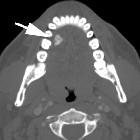mandibular lesions











Mandibular lesions are myriad and common. The presence of teeth results in lesions that are specific to the mandible (and maxilla) and a useful classification that defines them as odontogenic or non-odontogenic. While it may often not be possible to make a diagnosis on imaging alone, this classification is helpful to narrow the differential.
Classification
Although a histological classification is probably the most scientifically sound, as radiologists, we are presented with an image, and therefore it is easier to classify lesions according to location in the mandible and their appearance. For a detailed classification of odontogenic tumors, many more than even the keenest neuro/head and neck radiologist can ever remember, please refer to the 2005 WHO histological classification of odontogenic tumors.
Below the lesions are divided into cystic and solid. Cystic should not be confused with lytic as solid radiolucent lesions can also appear lytic (see: radiolucent lesions of the jaw).
Cystic lesions
- periapical cyst (or radicular cyst): common
- dentigerous cyst (or follicular cyst of the mandible): common
- odontogenic keratocyst (OKC): uncommon
- primordial cyst of the mandible
- Stafne cyst (or static bone cavity): uncommon
- solitary bone cyst of the mandible (or traumatic or haemorraghic bone cysts)
- aneursymal bone cyst (ABC): rare in the mandible
- residual cyst of the mandible
Solid lesions
Odontogenic
- benign
- odontoma: most common odontogenic tumor
- ameloblastoma: relatively common
- odontogenic myxoma (looks just like an ameloblastoma): rare
- calcifying epithelial odontogenic tumor (or Pindborg tumor) (looks just like an ameloblastoma): rare
- cementoblastoma: rare
- ameloblastic fibroma
- adenomatoid odontogenic tumor: rare
- condensing osteitis of the mandible
- malignant
- odontogenic carcinoma (e.g. ameloblastic carcinoma): rare
- odontogenic sarcoma: rare
- odontogenic carcinosarcoma: rare
Non-odontogenic
- benign
- idiopathic osteosclerosis
- cemento-ossifying fibroma
- juvenile ossifying fibroma
- exostosis (or torus mandibularis)
- osteoma
- fibrous dysplasia
- Paget disease
- central giant cell lesion/granuloma (giant cell reparative cyst)
- eosinophilic granuloma
- neurofibroma
- schwannoma
- malignant
- squamous cell carcinoma of mandible: common
- osteosarcoma
- Ewing sarcoma
- chondrosarcoma
- metastasis
- multiple myeloma/plasmacytoma
- lymphoma/leukemia
- fibrosarcoma
- leiomyosarcoma
Siehe auch:
- Osteom
- Fibröse Dysplasie
- Aneurysmatische Knochenzyste
- Chondrosarkom
- Ameloblastom
- Odontom
- Schwannom
- Multiples Myelom
- Torus mandibularis
- dentigerous cyst
- Neurofibrom
- Morbus Paget der Kalotte
- Keratozystischer odontogener Tumor
- cemento-ossifying fibroma
- WHO classification scheme for odontogenic tumours
- central giant cell granuloma
- Zementoblastom
- odontogenic myxoma
- lytische Läsionen der Mandibula
- solitary bone cyst of the mandible
- calcifying epithelial odontogenic tumour
- Calcifying epithelial odontogenic tumor
- Wurzelspitzenzysten
- ameloblastic fibroma
- primordial cyst of the mandible
- Stafne-Knochenkavität
- residual cyst of the mandible
- adenomatoid odontogenic tumour
und weiter:

 Assoziationen und Differentialdiagnosen zu Läsionen der Mandibula:
Assoziationen und Differentialdiagnosen zu Läsionen der Mandibula:

















